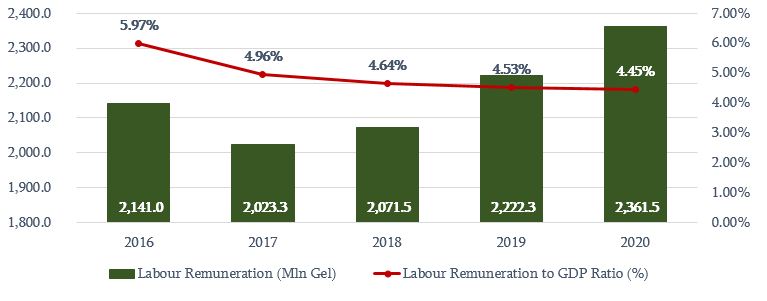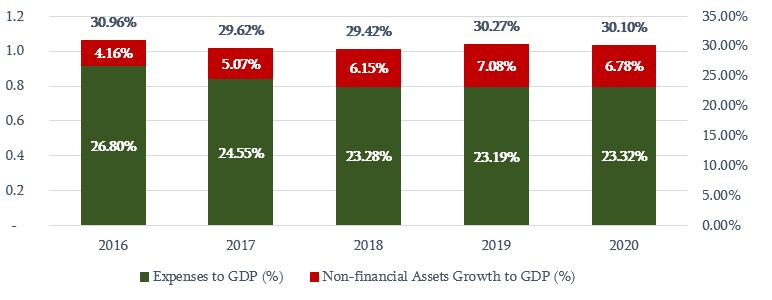Resume: The “small government” concept, as mentioned by the Minister of Finance of Georgia, is one of the initiatives voiced by the former Prime Minister, Mamuka Bakhtadze, upon his assumption of the Prime Minister’s duties. International organisations use several indicators simultaneously (International Monetary Fund, Fraser Institute, OECD) to measure a government’s size. Of these indicators, the total budget expenses to GDP ratio is the main one which is used most frequently. Despite this, members of government use the bureaucracy wage expenses to GDP ratio alone to measure the government’s size, something which is incorrect.
The figure named by the Minister of Finance does correspond to the reality. In accordance with the 2020 budget, bureaucracy labour remuneration constitutes 4.4% of the same period’s estimated GDP (the 4.8% named by Ivane Machavariani is a figure from the second presentation of the budget which was adjusted later) and in 2016-2020 has been characterised with a decrease trend.
However, whilst analysing the government’s size, the amount of funds under the government’s disposal is a very important indicator. To this end, the total sum of non-financial assets growth and expenses of the common budget is used. Unlike bureaucracy wage expenses, the share of funds under the government’s disposal in the GDP does not have a decrease trend. The government-managed resources to GDP ratio in 2016-2020 has been kept at around 30%. More specifically, that figure stands at 30.1% in 2020 and is slightly below the 2019 figure whilst being 0.5 and 0.7 of a percentage point higher as compared to the 2016 and 2017 figures, respectively.
In regard to the claim that the aforementioned figure (4.8%) is one of the lowest in the world, it is unknown what statistical data are being utilised by the Minister since this refers to the parameter of the budget which has not yet been approved. None of the international organisations publishes aggregated data (in real time) on the budgets of different countries in this form. The latest data in the World Bank database are from 2017 which are outdated for this discussion. Therefore, FactCheck refrains from discussing this particular part of the statement.
Analysis
The Minister of Finance, Ivane Machavariani, in his speech before the Parliament of Georgia, stated that the Government of Georgia remains faithful to the so called “small government” concept and bureaucracy wage expenses, constitute 4.8% of the gross domestic product according to the 2020 budget and considering the own income of the LEPLs. The Minister has also concluded that the aforementioned figure is one of the lowest in the world and for this assessment, he refers to the first 100 countries with the best standards of budget transparency.
The “small government” concept, as mentioned by the Minister of Finance of Georgia, is one of the initiatives voiced by the former Prime Minister, Mamuka Bakhtadze, upon his assumption of the Prime Minister’s duties. Since voicing that initiative and to the present day, the government is using the bureaucracy wages to GDP ratio to measure the government’s size. In fact, there is a myriad of indicators to measure a government’s size which are mostly based on the budget’s consolidated figures to GDP ratio. International organisations use several indicators simultaneously (International Monetary Fund, Fraser Institute, OECD) to measure a government’s size. Of those indicators, the total budget expenses to GDP ratio is the main one which is used most frequently. The total government expenses are the consolidated budget’s payables which include the government’s (central), the autonomous republic’s and the self-governing units’ payables and are all level government’s expenses to produce public goods and services. The second indicator is related to the number of employees in the public sector instead of their labour remuneration since budget payables already incorporate such expenses. Despite this, in order to give a successful assessment of the initiative, the government uses the bureaucracy wage expense component only. Of further note is that whilst initiating the small government concept, Mamuka Bakhtadze’s stated goal was to reduce that figure to 3.9% whereas that goal had already been achieved and had not required additional efforts from the government. FactCheck has published multiple articles on this topic (link 1, link 2, link 3 and link 4).
In accordance with the 2020 draft budget, the bureaucracy wage expense in the common budget is GEL 2.36 billion which is 4.4% of the estimated GDP (in his speech, Ivane Machavariani referred to the second presentation of the budget when that figure was at 4.8%). Graph 1 illustrates the changes of the respective data in the last years.
Graph 1: Labour Remuneration in the Common Budget

Source: Ministry of Finance of Georgia
However, whilst analysing the government’s size, the amount of funds under the government’s disposal is a very important indicator. To this end, the total sum of the non-financial assets growth and expenses components of the common budget is used. Graph 2 illustrates the respective data.
Graph 2: Common Budget Expenses and Non-financial Assets Growth to GDP Ratio

Source: Ministry of Finance of Georgia
As illustrated by the graph, unlike bureaucracy wage expenses, the government-managed funds to GDP ratio does not have a decrease trend. The common budget’s total expenses[1] to GDP ratio is kept at around 30%. More specifically, that figure stands at 30.1% in 2020 and is slightly below the 2019 figure whilst being 0.5 and 0.7 of a percentage point higher as compared to the 2016 and 2017 figures, respectively.
[1] Total sum of component of expenses and component of non-financial assets growth.








